Filtering of Seismic Data
The interpretation of seismic data is made purely on the basis of what is observed in the final processed section. CMP processing greatly enhances the signal to noise ratio and allows coherent reflections to be visible. However, the data that goes into the CMP processing is often contaminated with “noise”. The ground roll in the CSP gather shown previously is a good example. Also, the data might be contaminated with wind noise or instrument vibrations. These, and other types of noise, can be partially removed by using various filtering operations.
Three Useful Filtering Operations
1. Frequency Filtering
Wind, instrument, and cultural effects can generate unwanted noise at frequencies outside the seismic band. Often these are high frequency signals. Alternatively, ground roll and ship generated noise are low frequency. If this is the case then the seismic signal might lie in a frequency band that is distinct from the the noise. This is illustrated below. The unwanted noise can be removed using bandpass filtering in the frequency domain.

One can apply a frequency filter to remove all signals that have a frequency high than \(f_H\) and all frequencies lower than \(f_L\).
2. Deconvolution
a) Deghosting
In marine work a source is detonated slightly below the water surface. The primary seismic wavelet propagates downward but there is an upward propagating wave that reflects from the water surface and then propagates downward. The latter reflection is referred to as a “ghost”.
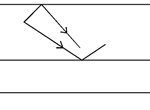
A seismic wavelet is composed of the original wavelet plus a closely spaced reflection. This complicates the wavelet as shown in the figure below.

b) Wavelet or Signature Deconvolution
An “inverse filter” is designed so that the original source wavelet is contracted to a narrower and symmetric form. e.g.

This can enhance the vertical resolution, though not beyond the “theoretical” maximum which is controlled by wavelength.
c) Predictive Deconvolution
This type of processing can remove some multiples from a seismic section. Reverberation (multiples of the ocean-bottom reflection) in marine surveys is a common example of this type of problem.
3. Velocity or \(f\mbox{-}k\) filtering
In shot gathers or on final sections we often have events that appear with a specific slope. Notice the ground roll, in the CSP gather below left. These are characterized by the late-arriving, high amplitude, low-frequency events which define a steep triangular-shaped central zone which mask the reflected arrivals.
Ground roll events have a small apparent velocity or equivalently a large dip. They can be isolated by taking a 2-D Fourier transform. In that domain the ground roll is located in a fan-like region. By zeroing the Fourier transform values in this fan and then inverse Fourier transforming, we remove the ground roll. The diagram below right sketches these fan-shaped regions of an \(f\mbox{-}k\) plot for a typical shot gather which contains reflections events and noise.
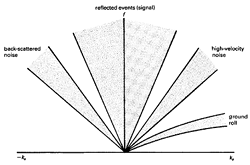
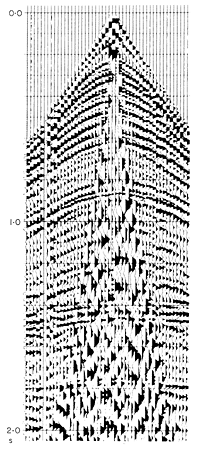
The procedure for carrying out \(f\mbox{-}k\) filtering is provided in the flow chart, below left. The final diagram shows four shallow marine records before and after \(f\mbox{-}k\) filtering to remove coherent linear noise. Hyperbolic reflections are observed after removal of the noise.
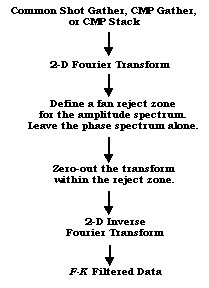
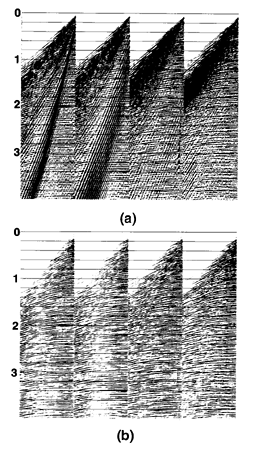
Four shallow marine records (a) before and (b) after f-k dip filtering to remove coherent linear noise. The coherent noise seen in these records is primarily of guided wave type.
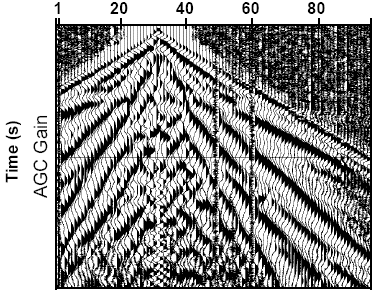 The figures to the right illustrate effects of low pass and high pass
filters. First examine the figure and try to identify aspects caused by
high frequencies. Then try to identify aspects caused by lower freqeuncy
components in the signal.
The figures to the right illustrate effects of low pass and high pass
filters. First examine the figure and try to identify aspects caused by
high frequencies. Then try to identify aspects caused by lower freqeuncy
components in the signal.